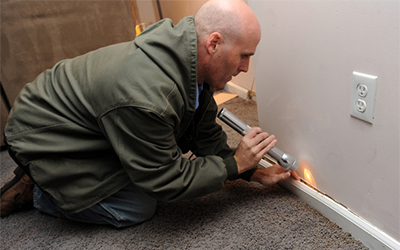
 |
| —*ADVERTISEMENT— |
 |
| Study Illustrates Why Foreclosed Homes Should Be Screened for Mold Study reports that 88 percent of foreclosures contained dangerous levels of Aspergillus flavus, a very infectious mold that is capable of causing human disease.  For several years, Aerobiologist Darryl Morris and Dr. Joseph Leija, co-founders of Midwest Aerobiology Labs, a MoldDNA laboratory, have researched how specific molds affect infants, often leading to an increased chance of childhood asthma. Their findings recently correlated to a study that isolated a panel of 36 molds specific to foreclosed homes. For several years, Aerobiologist Darryl Morris and Dr. Joseph Leija, co-founders of Midwest Aerobiology Labs, a MoldDNA laboratory, have researched how specific molds affect infants, often leading to an increased chance of childhood asthma. Their findings recently correlated to a study that isolated a panel of 36 molds specific to foreclosed homes.The study was performed by a team of environmental surveyors from the Midwest Aerobiology Labs organization. A result of this study was published in the Mold Code Handbook—Simple Solutions for Common Mold Problems Edition. Dust samples were collected from 41 foreclosed homes. Those samples were then analyzed for mold concentrations comprising of 20 molds commonly found in water-damaged homes. The final outcome was that out of the mold species that were identified, 88 percent of study foreclosed homes contained dangerous levels of Aspergillus flavus; a very infectious mold that is capable of causing human disease. Eighty-seven percent of study foreclosed homes had one or more molds that have been known to cause childhood asthma (Aspergillus ochraceus, Aspergillus unguis and Penicillum variabile) and 80 percent of study foreclosed homes had dangerous levels of Stachybotrys chartarum (Black Mold), which indicated that these homes had suffered severe water damage. "This study is very important because these molds associated with foreclosed homes have now been specifically identified," said Morris. Prior to this study, Midwest Aerobiology Labs developed a mold-sampling protocol using a method referred to as MoldDNA to detect specific molds with 99.9 percent accuracy. Dust samples are submitted to the lab, and in turn, the lab tests the sample for the presence of 36 common molds found in foreclosed homes. It provides accurate detection of mold and their spores down to the species. "The bottom line is that specific mold exposure increases health risk," said Morris. "So, it is prudent for homebuyers, realtors and property managers to properly sample, inspect for, and correct any water and mold problems in the home before purchasing or leasing if they wish to protect future inhabitant's respiratory health." Continue reading story |
 |